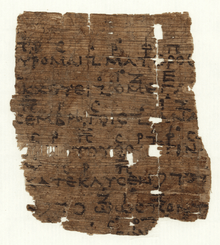Katolophyromai

Katolophyromai (Greek: κατολοφύρομαι), is the headword in a musical fragment from the first stasimon of Orestes by Euripides (lines 338-344, Vienna Papyrus G 2315). It means "I cry, lament so much." In 1892, among a number of papyri from Hermopolis, Egypt, in the collection of Archduke Rainer Ferdinand of Austria, a fragment was discovered and published[1] by the papyrologist Karl Wessely, containing a mutilated passage with musical notation. Although Vienna Papyrus G 2315 dates to the third century B.C., the melody recorded on it may have been written much earlier.[2]
Text
The full text of the musical fragment reads as follows:
κατολοφύρομαι, κατολοφύρομαι
ματέρος αἷμα σᾶς, ὅ σ’ ἀναβακχεύει,
ὁ μέγας ὄλβος οὐ μόνιμος ἐν βροτοῖς,
ἀνὰ δὲ λαῖφος ὥς τις ἀκάτου θοᾶς τινάξας δαίμων
κατέκλυσεν δεινῶν πόνων ὡς πόντου
λάβροις ὀλεθρίοισιν ἐν κύμασιν
- [I cry, I cry, your mother’s blood that drives you mad, great happiness in mortals never lasting, but like a sail of a swift ship, which a god shook up and plunged it with terrible troubles into the greedy and deadly waves of sea.]
The arrangement of the fragmentary text differs from the traditional editions, in which the lines begin with ματέρος αἷμα (mother’s blood) and κατολοφύρομαι appears after βροτοῖς (mortals). Unlike other fragments, however, the text and musical notations are quite well preserved.
Poetic features
The rhythm of the song is catalectic trochaic tetrameter and the tónos or trópos is Lydian. The preserved vocal notes coincide with the Ancient Doric or Phrygian harmonia transmitted by Aristides Quintilianus,[3] the Damon harmoniai, in enharmonic genus, which was usual in tragedy of fifth century BC.
Authorship
Whether this fragment represents the original music Euripides composed in 408 BC is an open question, given also the absence of 5th century BC musical inscriptions. Nevertheless, there is some evidence in favour of the authenticity. Psellus and Plutarch credit Euripides and Agathon with the introduction of chromatic genus and the fragment accords with it but also with observations of Dionysius of Halicarnassus and Aristophanes about the complexity of Euripidean style, which appear in the source: alteration of textual rhythm, reduplication of syllables and chromatic or disjunct musical lines. If the Hellenistic and Roman era musicians and musicologists imitated and reproduced the Classical works the same way librarians, grammarians, Atticists did for literature, this would be another argument or point of further discussion.
See also
References
- ↑ Mitteilungen aus der Sammlung der Papyrus Erzherzog Rainer vol. 5 part 3
- ↑ Thomas J. Mathiesen (1999) places it about 125 years after the death of Euripides. Cambridge University Press (1928) in the Augustan age.
- ↑ Aristides Quintilianus. On Music 1.18 and 2.80. https://books.google.com/books?id=8xS_ky1OhqAC&pg=PA392&lpg=PA392&dq=Aristides+Quintilianus+On+Music&source=bl&ots=wx0nTNxSRn&sig=os9mEJO5UimjIGM7Qx4oMhaiiwM&hl=en&sa=X&ved=0ahUKEwihv6zJ5eXRAhXs24MKHfhhCoYQ6AEISDAJ#v=onepage&q=Aristides%20Quintilianus%20On%20Music&f=false
Further reading
- Apollo’s lyre: Greek music and music theory in antiquity and the Middle Ages By Thomas J. Mathiesen Pages 116-124 (1999)
- The Orestes of Euripides Excursus B, the Musical Fragment, Pages 203-204 Cambridge University Press (1928).
External links
- Performance by Daemonia Nymphe, by Petros Tabouris
- Translation of the fragment by Dr. Norman Prinsky
- The whole stasimon, lines 316 – 347 in English and Greek from Perseus Project
|
| |
|
| |
|
| |
|
|